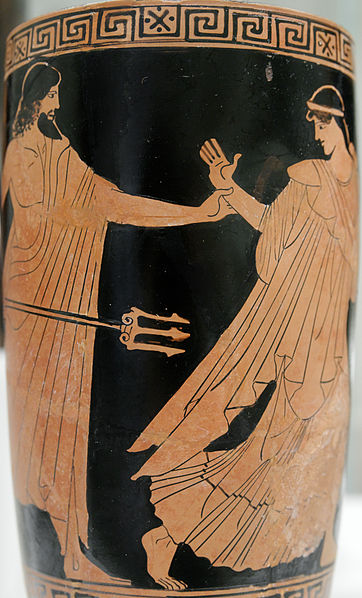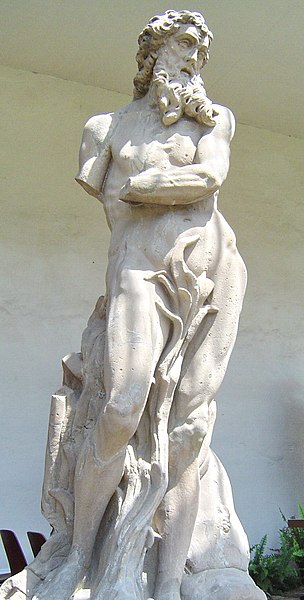In ancient Greek mythology, Amphitrite was the goddess of the sea, the queen of the sea, and her consort is Poseidon. She was a daughter of Nereus and Doris. Under the influence of the Olympian pantheon, she became the consort of Poseidon and was later used as a symbolic representation of the sea. Her Roman counterpart is Salacia, a comparatively minor figure, and the goddess of saltwater.
Amphitrite with downturned trident, by François Théodore Devaulx (1866)
Amphitrite ("Aphirita") bearing a trident on a pinax from Corinth (575–550 BC).
Theseus and Amphitrite clasp hands, with Athena looking on (red-figure cup by Euphronios and Onesimos, 500–490 BC)
Sea thiasos depicting the wedding of Poseidon and Amphitrite, from the Altar of Domitius Ahenobarbus in the Field of Mars, bas-relief, Roman Republic, 2nd century BC
Poseidon is one of the Twelve Olympians in ancient Greek religion and mythology, presiding over the sea, storms, earthquakes and horses. He was the protector of seafarers and the guardian of many Hellenic cities and colonies. In pre-Olympian Bronze Age Greece, Poseidon was venerated as a chief deity at Pylos and Thebes, with the cult title "earth shaker"; in the myths of isolated Arcadia, he is related to Demeter and Persephone and was venerated as a horse, and as a god of the waters. Poseidon maintained both associations among most Greeks: he was regarded as the tamer or father of horses, who, with a strike of his trident, created springs. His Roman equivalent is Neptune.
The Poseidon of Melos, a statue of Poseidon found in Milos in 1877
Poseidon greeting Theseus (on the right). Detail, Attic red-figured calyx-krater by Syriscos Painter, 450-500BC from Agrigento. BnF Museum (Cabinet des médailles), Paris
Poseidon pursuing a woman, probably by Achilleus painter, 480-450BC. Metropolitan Museum of Art, Manhattan NY
Statue of Poseidon in Germany by Johann David Räntz and Lorenz Wilhelm Räntz (1760).








